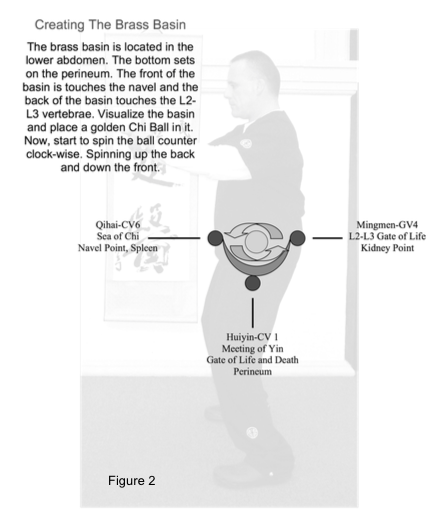The Brass Basin
Visualization is the first step in Qigong practice and Qigong breathing. Learning to feel chi and using the mind/eye/heart power of “Yi” to guide the chi flow through the energy routes in your body is the foundation to Qigong practice. You must see the Brass Basin in your mind before you can lead the chi through the small circuit and ultimately the large circuit or whole body.

Qigong Breathing
Life starts and ends by taking a breath and it is obvious that we should fill our lives with good breathing habits. Our bodies need a lot of oxygen to function properly and to help discard waste products like carbon monoxide. Every cell in the body actually needs lots of oxygen. Today many people are conscious about what they drink and what they eat but very few think about how they breathe!
Breathing affects the whole body. It affects the nervous system, the heart, the digestive system, muscles, sleep, energy levels, concentration, memory and much more. Breathing is also our largest system for waste removal. Seventy percent of the waste products produced in our body are supposed to be removed via breathing, 20% are removed via the skin and only 10% should remain for the kidneys and the digestive system to eliminate. We not only breathe in oxygen but also life energy (Qi or Chi in China, Ki in Japan, Mana in India).
The majority of people only use chest breathing. This type of breathing is easily affected; it becomes easily restrained or blocked. Our way of breathing is actually one of the first affected by stress and emotions. According to a recent study in Sweden, 83% of the adult population uses chest breathing, i.e., they only use the top part of the chest. This is a very uneconomical way of breathing as it uses more muscle power than the deeper and more relaxed abdominal breathing. People who use chest breathing take less effective breaths and, as a consequence, receive less oxygen and get rid of fewer waste products.
Abdominal breathing is effective breathing. Deep and effective breathing reaches all the way down to the abdomen. The abdomen expands forward, to the sides and also towards the spine. The breathing movement can be felt all the way down to the pelvic area and up to the top of the lungs. Abdominal breathing has a calming and relaxing effect as we take fewer and but more effective breaths. We absorb more oxygen and release more waste products with each breath. As an added bonus we also add more life energy, Qi, to our system by using abdominal breathing.
Don’t use your chest to breathe. Use your abdomen. One of my Qigong masters used to say that abdominal breathing is like a return to childhood. Abdominal breathing not only makes us breathe like we did when we were children, it can also rejuvenate bodily functions and organs. Children are still unaffected by the habits and defense mechanisms we learn as adults and breathe naturally. If you observe the breathing of a child lying on its back, you can see how he/she breathes in the rhythmic rise and fall of the abdomen as life energy is absorbed. My master referred to abdominal breathing as natural breathing and chest breathing as reversed breathing. Abdominal breathing can be considered as taught by nature, chest breathing is a constriction imposed by the self.
